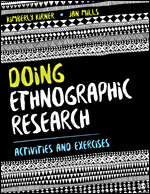1. The Basics of Research Design
Activity 1.1: Ways of Knowing (Personal Reflection)
Activity 1.2: Identifying Researchers’ Approach
Activity 1.3: Dependent and Independent Variables
Activity 1.4: Variables, Indicators, and Values
Activity 1.5: Operationalizing Definitions
Activity 1.6: Research Interest Reflection
Activity 1.7: Finding a Topic: Your Research Project
Self- or Peer-Assessment for Chapter 1
2. Ethics
Activity 2.1: Personal Ethics Self-Evaluation (Personal Reflection)
Activity 2.2: Operationalizing the AAA Code of Ethics
Activity 2.3: Exploring Relationships of Responsibility
Activity 2.4: Ethical Dilemmas
Activity 2.5: Research Design Decisions: Recruitment
Activity 2.6: Research Design Decisions: Positionality
Activity 2.7: Research Design Decisions: Risk Assessment and Management
Self- or Peer-Assessment for Chapter 2
3. Sampling
Activity 3.1: Personal Sampling Self-Evaluation (Personal Reflection)
Activity 3.2: Cultural Data versus Individual Attribute Data
Activity 3.3: NonProbability Sampling Plans
Activity 3.4: Critiquing the Choice of Informants
Activity 3.5: Probability Sampling Plans
Activity 3.6: Sampling Frames
Activity 3.7: Research Design Decisions: Sampling Plan
Self- or Peer-Assessment for Chapter 3
4. Participant Observation
Activity 4.1: Participant Observation Self-Evaluation (Personal Reflection)
Activity 4.2: Showing, Not Telling
Activity 4.3: Reflexivity
Activity 4.4: Introductory Participant Observation
Activity 4.5: Research Design Decisions: Anticipating Field Challenges and Planning for Where/When/How/What
Activity 4.6: Research Project: Participant Observation—Jottings
Self- or Peer-Assessment for Chapter 4
5. Writing Field Notes
Activity 5.1: Writing Field Notes Self-Evaluation (Personal Reflection)
Activity 5.2: Correcting Pitfalls
Activity 5.3: Selection: Inscribing Reality
Activity 5.4: Presentation: Inscribing Reality
Activity 5.5: Analytical Commentaries
Activity 5.6: Research Project: Writing Field Notes
Activity 5.7: Autoethnography
Self- or Peer-Assessment for Chapter 5: Activity 5.6
Self- or Peer-Assessment for Chapter 5: Activity 5.7
6. Interviewing
Activity 6.1: Interviewing Self-Evaluation (Personal Reflection)
Activity 6.2: Correcting Interview Questions
Activity 6.3: Constructing an Interview Guide for Peer Interviews
Activity 6.4: Constructing an Informed Consent Form for Peer Interviews
Activity 6.5: Peer Interviews
Activity 6.6: Research Design Decisions: Preparing an Interview Guide and a Consent Form
Activity 6.7: Research Project: Interviews
Self- or Peer-Assessment for Chapter 6
7. Coding and Analysis
Activity 7.1: Coding and Analysis Self-Evaluation (Personal Reflection)
Activity 7.2: Abbreviating, Coding, and Analysis
Activity 7.3: Inductive versus Deductive Coding
Activity 7.4: Manifest versus Latent Content
Activity 7.5: Content Analysis of TV Shows
Activity 7.6: Practicing Grounded Theory
Activity 7.7: Research Project: Coding and Analysis Using Grounded Theory
Activity 7.8: Writing Ethnographic Narrative
Self- or Peer-Assessment for Chapter 7: Activity 7.7
Self- or Peer-Assessment for Chapter 7: Activity 7.8
8. Surveys and Mixed Methods Design
Activity 8.1: Reflections on User Experience Self-Evaluation (Personal Reflection)
Activity 8.2: Mixed Methods Design
Activity 8.3: Triangulation
Activity 8.4: Practicing Constructing Survey Questions
Activity 8.5: Practicing Survey Distribution Decisions
Activity 8.6: Practicing Survey Data Analysis
Activity 8.7: Research Design Decisions: Constructing Survey Questions
Activity 8.8: Research Design Decisions: Preparing a Survey and Consent Page
Activity 8.9: Research Project: Survey Data Collection, Analysis, and Write-Up
Self- or Peer-Assessment for Chapter 8
9. Cultural Domains: Modeling Cognition and Knowledge
Activity 9.1: My Taxonomies and Cultural Models Self-Evaluation (Personal Reflection)
Activity 9.2: Practicing Folk Taxonomy Study Design
Activity 9.3: Practicing Folk Taxonomy Data Collection and Analysis
Activity 9.4: Practicing Cultural Models Study Design
Activity 9.5: Practicing Cultural Model Data Collection and Analysis
Activity 9.6: Practicing Decision-Tree Model Study Design
Activity 9.7: Practicing Decision-Tree Model Data Collection and Analysis
Activity 9.8: Research Design Decisions: Cultural Domains Study
Activity 9.9: Research Project: Cultural Domain Study
Self- or Peer-Assessment for Chapter 9
10. Indirect Observation: Material Culture and Using Archives or Media
Activity 10.1: My Indirect Observation Self-Evaluation (Personal Reflection)
Activity 10.2: Practicing Visual and Material Culture Study Design
Activity 10.3: Practicing Visual and Material Culture Collection and Analysis
Activity 10.4: Practicing Diary Study Design
Activity 10.5: Practicing Diary Study Collection and Analysis
Activity 10.6: Practicing Archival Study Design
Activity 10.7: Practicing Archival Study Collection and Analysis
Activity 10.8: Research Design Decisions: Selecting an Indirect Observation Study
Activity 10.9: Research Project: Indirect Observation Study
Self- or Peer-Assessment for Chapter 10
11. Behavior and Context: Mapping and Passive Direct Observation
Activity 11.1: Behavior and Context Self-Evaluation (Personal Reflection)
Activity 11.2: Practicing Participatory Mapping Study Design
Activity 11.3: Practicing Participatory Mapping
Activity 11.4: Practicing Mobility Mapping
Activity 11.5: Continuous Monitoring: Creating an Ethogram
Activity 11.6: Continuous Monitoring: Using an Ethogram and Writing
Activity 11.7: Research Design Decisions: Selecting a Behavior and Context Study
Activity 11.8: Research Project: Behavior and Context Study
Self- or Peer-Assessment for Chapter 11
12. Putting It All Together: Culminating Experiences
Activity 12.1: Integrating Skills Self-Evaluation (Personal Reflection)
Activity 12.2: Human Subjects Protocol for Institutional Review Board (IRB)
Activity 12.3: Grant Proposal
Activity 12.4: Technical Report
Activity 12.5: Paper Presentation
Activity 12.6: Poster Presentation
Self- or Peer-Assessment for Chapter 12: Activity 12.2
Self- or Peer-Assessment for Chapter 12: Activity 12.3
Self- or Peer-Assessment for Chapter 12: Activity 12.4
Self- or Peer-Assessment for Chapter 12: Activity 12.5
Self- or Peer-Assessment for Chapter 12: Activity 12.6

 Sage College Publishing
Sage College Publishing


